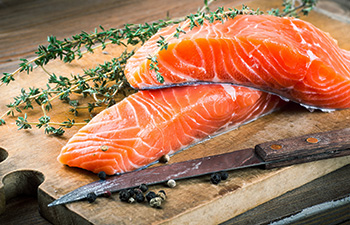
Trout Description & Health Benefits
- Trout are a member of the Salmonidae family and are closely related to salmon and char.
- Trout is the common name for various species, including rainbow trout, brown trout, and brook trout. Rainbow trout is commonly found in grocery stores.
- Trout are an excellent source of protein, niacin, vitamin B12, and omega 3 fatty acids.
- Protein is the building blocks of our body. It is important in growth and development and assists in repairing damaged tissues.
- Niacin is important in converting the food we eat into energy as well as assisting with digestive, skin, and nerve functions within the body.
- Vitamin B12 is required to form red blood cells which deliver oxygen throughout the body. B12 is also essential in supporting brain health and in creating DNA which holds our genetic material.
- Omega 3 fatty acids are necessary for brain function by aiding in memory, performance, and behavior as well as assisting with normal growth and development. Research has also shown that omega 3 fatty acids reduce inflammation and may help lower your risk of chronic disease such as heart disease, cancer, and arthritis.
- Many people have concerns about mercury and fish. Trout is an excellent option when eating fish due to its high omega 3 fatty acid content and its low levels of mercury. If eating locally caught trout, contact your DNR to find specific eating recommendations. The Wisconsin DNR has a publication called Choose Wisely, a health guide for eating fish in Wisconsin.
- If you are interested in learning more about how to find sustainable and healthy fish to consume, check out seafoodwatch.org
- The USDA recommends eating 8 oz. of a variety of fish each week for optimum nutrition.
Purchasing, Selecting, Storing, and Preparing
- When purchasing fresh trout, it should be refrigerated or displayed on a thick bed of ice.
- Trout should smell fresh and mild, avoid if it smells too fishy, sour, or ammonia-like.
- The flesh should be shiny, firm, and free from slime.
- Fillets should display no discoloration, darkening, or drying around the edges.
- If purchasing frozen trout, avoid packages that have been tampered with or those with ice crystals. Ice crystals signify a food has been thawed and refrozen.
- Soon after purchasing, store trout in the refrigerator if using within two days or in the freezer if not using right away.
- When thawing trout, place in the refrigerator overnight. If the trout needs to be thawed sooner, seal in a plastic bag and immerse in cold water.
- Seafood should be cooked to a temperature of 145°F. Insert a food thermometer to check the temperature. If you do not have a thermometer, fish should be flaky and separate easily with a fork.
Nutrition Facts
3 oz. cooked, dry heat
Calories: 162 | Protein: 22.64 g | Fat: 7.20 g | Carbohydrate: 0 g | Fiber: 0 g | Calcium: 47 mg | Magnesium: 24 mg | Potassium: 394 mg | Vitamin C: 0.4 mg | Folate: 13 μg | Vitamin A: 54 IU
Request an Appointment

